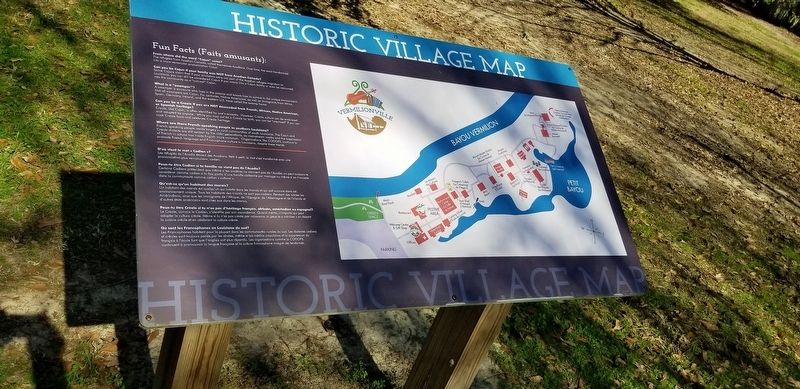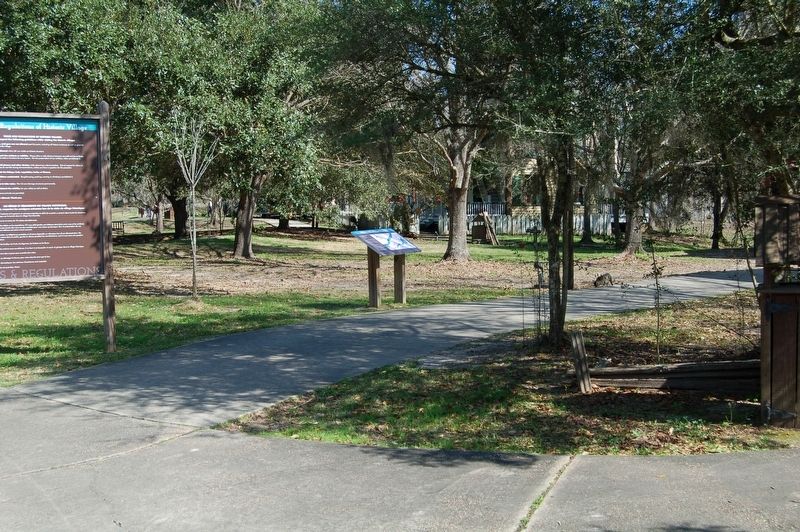Historic Village Map
Fun Facts (Faits amusants)
From where did the word "Cajun" come?
The refugees from Acadian Canada, called themselves Acadians. Over time, the word transformed into more vernacular pronunciation Cajun
Can you be Cajun if your family was NOT from Acadian Canada?
Some Cajuns claim that if your ancestors were not part of the Acadian refugee migration to Louisiana, you can still be considered Cajun if you marry into a Cajun family or even be welcomed into the community as a "cultural" Cajun.
What is a "swamper"?
A swamper is someone who lives in the swamp and knows how to survive in the unique environment. Not all swampers are Cajun. For centuries, Native Americans, as well as immigrants from Africa, Spain, Germany, Ireland and the eastern U.S. have called the swamp home.
Can you be a Creole if you are NOT descended from French, Africa, Native American or Spanish heritage?
Creole, like Cajun, is often identified by one's ancestry. However, Creole culture can be embraced and adopted by anyone. While you may not be a Creole by birth, you can be "creolized” if you can cook Creole food and celebrate Creole heritage.
Where are there French-speaking people in southern Louisiana?
French-speaking people reside largely in rural communities of south Louisiana. The Cajun and Creole dialects are still spoken by the older generations, as mainstream media and the suppression of French in school has made English more common. Organizations like CODOFIL continue to promote French language and Francophone culture in Louisiana, despite these trends.
---------------------------------------------------------------------------------------
D'où vient le mot « Cadien »?
Les réfugiés de l'Acadie étaient des Acadiens. Petit à petit, le mot s'est transformé avec une
prononciation plus vernaculaire, cadien.
Peux-tu être Cadien si ta famille ne vient pas de l'Acadie?
Certains Cadiens prétendent que même si tes ancêtres ne viennent pas de l'Acadie, on peut toujours te
considérer comme cadien si tu fais partie d'une famille cadienne par mariage ou même si on t'accepte
dans la communauté comme cadien « culturel ».
Qu'est-ce qu'un habitant des marais?
Un habitant des marais est quelqu'un qui habite dans les marais et qui sait survivre dans cet
environnement unique. Tous les habitants des marais ne sont pas cadiens. Pendant des siècles les
Amérindiens, ainsi que les immigrants de l'Afrique, de I'Espagne, de l'Allemagne et de l'Irlande et
d'autres états américains sont chez eux dans les marais.
Peux-tu être Créole si tu n'as pas d'héritage français, africain, amérindien ou espagnol?
Le Créole, comme le Cadien, s'identifie par son ascendance. Quand même, n'importe qui peut
adopter la culture créole. Même si tu n'es pas créole par naissance, tu peux te « créoliser » en faisant
la cuisine créole et en célébrant la culture créole.
Où sont les Francophones en Louisiane du sud?
Les Francophones habitent pour la plupart dans les communautés rurales du sud. Les dialectes cadiens
et créoles sont toujours parlés par les aînées, même si les médias populaires et la suppression du
français à l'école font que l'anglais soit plus répandu. Les organisations comme le CODOFIL
continuent à promouvoir la langue française et la culture francophone malgré
ces tendances.
Topics. This historical marker is listed in this topic list: Settlements & Settlers.
Location. 30° 12.902′ N, 91° 59.744′ W. Marker is in Lafayette, Louisiana, in Lafayette Parish. Marker can be reached from Fisher Road near Surrey Street (State Road 728-8). Touch for map. Marker is at or near this postal address: 300 Fisher Road, Lafayette LA 70508, United States of America. Touch for directions.
Other nearby markers. At least 8 other markers are within walking distance of this marker. Vermilionville Historical Timeline (here, next to this marker); a different marker also named Vermilionville Historical Timeline (here, next
More about this marker. Located on the grounds of the Vermilionville Heritage Museum, Admission required.
Also see . . . Vermilionville. Museum website homepage (Submitted on June 7, 2019, by Cajun Scrambler of Assumption, Louisiana.)
Credits. This page was last revised on February 25, 2024. It was originally submitted on June 7, 2019, by Cajun Scrambler of Assumption, Louisiana. This page has been viewed 312 times since then and 27 times this year. Photos: 1, 2. submitted on June 7, 2019.

